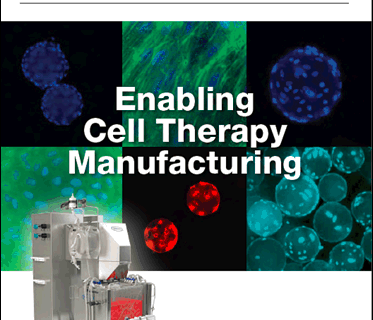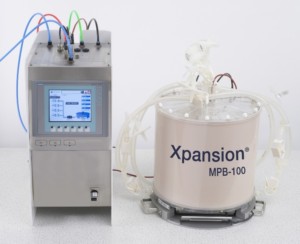
A Look at the State of Cell Therapy – Current Manufacturing Options and Opportunities for Further Advancements – Part I
Introduction
In September, BioProcess International in conjunction with Pall Life Sciences published a very detailed and informative supplement titled, “Enabling Cell Therapy”. The publication contains twelve articles all covering various aspects of the Cell Therapy industry and related manufacturing. I found the supplement so useful, that I have provided highlights from the articles in a two part Cell Therapy blog. Part II will be published tomorrow. For full details, please see the original supplement.
Cell Therapy Industry Overview
The Cell Therapy industry is still young but has already generated significant interest and excitement around the potential therapeutic value of its products. As a developing industry, there are still many challenges related to large scale manufacturing that need to be addressed. At the moment there are only a handful of companies readying themselves for large-scale commercial manufacturing, but the industry pipeline is impressive and sizable.
An initial challenge for commercial Cell Therapy manufacturing is charting new territory both in manufacturing and in regulatory expectations. While the Cell Therapy industry may be able to adapt some biomanufacturing practices and equipment from proven protein and vaccine manufacturing platforms, there is still work to be done. The most significant difference being that in protein based drugs and vaccines, the product is secreted into the media and the cells are simply the manufacturing vehicles, however in Cell Therapy, the cells are the product and this presents a whole host of issues that are still being explored with several potential solutions in development.
From a business perspective Cell Therapy companies may find it is beneficial and necessary to partner with contract manufacturing organizations who have extensive manufacturing experience, suppliers who can help develop solutions for various manufacturing scenarios and possibly large pharmaceutical companies, who have the money and experience in taking drugs through regulatory approval and commercialization. As pointed out in the supplement, one of the biggest unknowns at the moment for the industry is how will these cell therapies be reimbursed by insurance and other governmental healthcare agencies. Personalized medicine has been shown to be quite expensive, but even with allogeneic therapies where the cell treatment isn’t personalized, there is still quite a bit of concern regarding the price of these cell based drugs. These issues further highlight the need for the Cell Therapy industry to produce a product in the most cost effective way possible.
While there have been cell based therapies approved and commercialized, there have also been setbacks and failures. In order to really move the industry forward, there may need to be some significant therapy success stories to pave the way and draw further investment. Investment would provide necessary funding to develop additional new drugs and the associated manufacturing tools needed for large-scale manufacturing. Some have indicated that it just may be the success of CAR T-cell immunotherapies for cancer that provide the needed boost, as they certainly have generated a great deal of attention, impressive clinical results, and big investment.
While it is clear that new manufacturing solutions are needed for this burgeoning industry, there are also good resources currently available. This supplement does a great job highlighting manufacturing options and also pointing out areas where work still needs to be done. While some suppliers may feel that the Cell Therapy industry is too young and are waiting to see how the market evolves before investing significant resources in developing new products; Pall states that while there is some risk in investing in product development for this industry they want to be first to market. As such, they are developing solutions to meet several challenges that are arising as scale increases. They have stated that their goal is to “provide a total manufacturing solution for the future Cell Therapy company,” and as this supplement indicates they are investing a good deal of expertise and resources to accomplish this.
For more information on the Cell Therapy industry overview, please see the following articles from the Enabling Cell Therapy supplement:
- Enabling Cell Therapy Manufacturing
- Positioning for Success: An Interview with Mario Philips
- Positioning Tools, Technologies, and Talents for Cell Therapies: An Interview with Harvey Brandwein
Cell Therapy Manufacturing Platforms
Key drivers for successful manufacturing of cell therapies, as identified in several of the supplement pieces, are the ability to efficiently address scale, cost, flexibility and to conduct the work in a closed system. This necessitates the need to move away from more research based processes to clinical and commercial manufacturing processes.
The first step in Cell Therapy manufacturing is to isolate cells from selected tissue, whether that is donor tissue for allogeneic therapies or the patient’s own tissue in the case of autologous therapies. After the cells have been selected, they must be expanded to therapeutic levels, one key challenge here is that in order for the therapy to be effective the cells must maintain their phenotype, function and in most cases must remain undifferentiated. Because these cells are primary cells this isn’t an easy task. After expansion, cells need to be harvested and stored for eventual delivery to patients.
Most Cell Therapy companies are comfortable and used to working at research manufacturing levels. However as therapies move from animal studies into the clinic these companies need to determine how they will manufacture their product moving forward. This decision is largely based on what type of therapy they are manufacturing, autologous or allogeneic, and the total number of cells they will need to meet commercial demand.
Since most of the small-scale culture work is done in 2D culture vessels, this is a defined and well-tested method, however at the commercial demand most cell therapies will, 2D culture may not be sufficient. In the supplement, it is estimated that based on dose and market size, allogeneic therapies may need to be in the range of 100 billion to trillion cell lot sizes. In these cases, there is little option, but to move to 3D culture.
Expansion
Planar technologies – examples: flasks, multilayer vessels and multiplate bioreactors
Maximum estimated lot size – 100-400 billion cells for most adult primary cells
Planar technologies involve expanding cells using adherent 2D culture on flat vessels. As mentioned, almost all cell therapies  begin with this type of culture in flasks or multilayer vessels, such as cell stacks or cell cubes. Advancements in these products including automation, increases in surface area, and robotics have permitted scale up and have allowed some therapy products to move from mid-late stage clinical development using these systems. Another advancement in planar technologies is the multiplate bioreactor, like the Xpansion bioreactor by Pall. With the Xpansion, more plates can be cultured in a smaller footprint, thus enabling a larger number of cells per lot, all with the benefit of added bioreactor controls.
begin with this type of culture in flasks or multilayer vessels, such as cell stacks or cell cubes. Advancements in these products including automation, increases in surface area, and robotics have permitted scale up and have allowed some therapy products to move from mid-late stage clinical development using these systems. Another advancement in planar technologies is the multiplate bioreactor, like the Xpansion bioreactor by Pall. With the Xpansion, more plates can be cultured in a smaller footprint, thus enabling a larger number of cells per lot, all with the benefit of added bioreactor controls.
Suspension technologies – examples: microcarrier culture and aggregate culture
Maximum estimated lot size – several hundred billion to trillions of cells
Suspension technologies involve expanding cells using 3D culture. Use of this technology usually involves a manufacturing change from 2D to 3D as most small-scale expansion occurs in 2D planar technologies. To reach necessary lot sizes cost effectively and meet the estimated demand for most allogeneic cell therapies, suspension culture utilizing existing bioreactor technology is the only viable option at the moment.
Microcarriers
Expansion
Microcarriers are one type of suspension culture that can be employed utilizing existing bioreactor technology. In microcarrier culture, the culture media and microcarriers are added to the bioreactor and cells are then seeded at the appropriate concentration for attachment to carriers. Once cells come into contact with a microcarrier in suspension they attach and spread over the surface of the microcarrier via cell division. Successful culture requires optimization of several factors including microcarrier surface characteristics and concentration, cell seeding density, media formulation, mixing dynamics to reduce shear stress and environmental controls.
The use of microcarriers has many benefits when compared with planar technologies, particularly in large-scale manufacturing. Benefits include an increase in surface area to volume ratio, which increases cell density while reducing the manufacturing footprint. The use of bioreactors also permits greater culture control because you have the process parameter controls initially instituted for biopharmaceutical manufacturing, such as gas exchange, nutrient feeding and pH monitoring. While there are benefits, there are also complications in changing to this system including the introduction of shear stress, which must be closely controlled because stem cells are particularly susceptible. The shear is generated from the stirring of the impellers in a traditional bioreactor set up and one identified alternative is a rocking platform bioreactor.
Harvest
Once expansion is complete, cells need to removed from the microcarrier. Enzymatic treatment is a common method, followed by motion disruption. There are also microcarriers that feature new surface chemistries that enable non-enzymatic removal. Cell harvest techniques can include tangential flow filtration (TFF) and sequential differential centrifugation but they require extensive optimization and validation.
Aggregate Culture
An alternative to microcarriers is to culture the cells as aggregates in the bioreactor with no microcarrier or extracellular matrix. The challenge with this method is that large aggregate size is problematic and requires aggregates be passaged frequently to prevent formation or once formed, the aggregates need to be split up. Another challenge is maintaining cell function as volume increases because studies have shown that cells in high density situations tend to want to differentiate into mature adult cells, which in most cases diminishes their therapeutic potential.
Downstream Processing
In Cell Therapy downstream processing is largely comprised of two steps. Volume reduction and final product fill. Methods for volume reduction depend on the harvest volume, while small harvest volumes can be reduced fairly easily with existing technology, volumes greater than 5-10 liters need to employ other methods that have been adapted from traditional biopharmaceutical manufacturing. This is an area identified in the supplement as still needing improvement.
As companies move their products toward commercialization, lot sizes will increase and with this increase there will be bottlenecks in downstream processing. These bottlenecks will need to be addressed with new technologies to enable cost effective production for Cell Therapy commercialization.
For more information on Cell Therapy manufacturing platforms, please see the following article from the Enabling Cell Therapy supplement:
- Meeting Lot-Size Challenges of Manufacturing Adherent Cells for Therapy
- Ask the Experts: Core Technologies Expand Opportunities for Cell Therapy Manufacturing
Tomorrow don’t miss Part II of this two-part series on Cell Therapy.